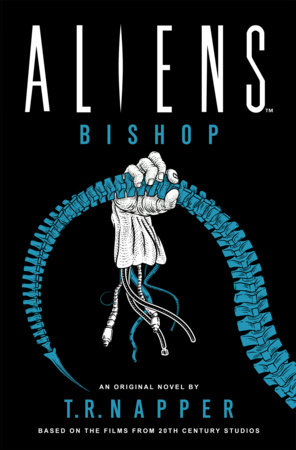My rating: 4 of 5 stars
Feels like a middle episode in a longer story.
Writing a tie-in novel has benefits and drawbacks. The benefits are that the writer gains exposure to a broader readership by producing a book in an already established and popular intellectual property. If they happen to be a fan of that IP, they also get the buzz of playing with that universe’s characters, worlds and situations. A drawback is that the IP can sometimes be a creative straitjacket. Some things will be off-limits to the author, and significant changes to characters or situations may only be able to be pushed so far.
TR Napper’s Aliens: Bishop comes off the back of his successful Aurealis award winning novel 36 Streets, which I loved. That novel features solid worldbuilding, painting a vivid picture of a cyberpunk future Vietnam populated by well-rounded and complex characters, some beautiful action set pieces and a clever exploration of a memory recording and deleting technology and what that tech means for the individual and humanity as a whole. Napper clearly relishes playing in the Aliens universe and there’s some well-drawn and sometimes surprising characters in the novel along with some interesting mediations by Bishop on humanity and artificial intelligence and memory (which riff off some of the discussions in 36 Streets), but the story of Aliens: Bishop feels like the middle part of a longer narrative.
The artificial human Bishop is of course a significant and much-loved character in the Aliens universe. Beautifully played by Lance Hendriksen and first appearing in Aliens, his story is a classic redemptive arc. At first mistrusted by Ripley because of her experience with the murderous Ash on board the Nostromo, Bishop becomes her most valuable ally ultimately helping her destroy the alien hive on LV-426 and saving her, Hicks and Newt from certain death. Badly damaged by the alien queen at the end of Aliens, he again helps Ripley when she crashes on prison planet Fury 161 in Alien 3. His creator Michael Bishop turns up at the end of that movie to try to rescue the alien queen implanted in Ripley. But things don’t go as planned.
When Aliens: Bishop picks up the story, Michael has salvaged the damaged Bishop from Fury 161 and uploaded his mind into a new body. Michael no longer works for Weyland-Yutani and wants Bishop to share all the knowledge of the aliens he amassed during his studies of the creatures on LV-426. Michael says he wants to use this knowledge for the good of humanity, but Bishop isn’t convinced – although he feels ungrateful and doesn’t wholly understand why he’s withholding the data from his creator. Instead, he agrees to help Michael in his studies of alien material on board Michael’s ship.
Meanwhile a group of Colonial Marines accompanied by a Weyland-Yutani executive are looking for Bishop. Weyland-Yutani wants its android and all the knowledge it amassed back. The leader of the marines, Captain Marcel Apone – brother of that Apone – wants revenge and he’s prepared to exceed his orders and authority to get it. Apone is a great character, evoking his cigar-chewing brother from Aliens but being different enough for us to feel he is his own man. The first few chapters in the novel centre on Apone and his Marines getting ready for their mission. Apone’s presence and the familiar wisecracks and gung-ho, can-do attitude of the Marines pull us firmly into the Alien universe from the get go.
It also introduces the first of three more point of view characters. Australian refugee Karri Lee is a new recruit to the unit and doing her best to fit in. It seems future Australia isn’t doing too well and some of its woes have to do with the British (who would have thought!). The two other point of view characters are introduced in a parallel plot. Xuan Nguyen is a medic and crew member on board the Nha Trang a ship of the Union of Progressive Peoples engaged in food smuggling. She enjoys her life on board with the crew and there’s a similar vibe to some of the characters and scenes in 36 Streets. Unfortunately, their current voyage is interrupted by the arrival of the Xinjiang a Chinese warship, which contains the final pov character Commander Su Wong. Under orders from her Captain, Wong leads Xuan and her fellow crew members to a ‘decontamination chamber’ studded with fleshy eggs…
While the character work and Bishop’s musings are strong elements of Aliens: Bishop, the plot feels less original. Xuan and her friends find out what’s in those eggs and the results are as you might expect. Meanwhile the Marines are on a familiar search and rescue mission, fighting their way through opposing forces and aliens to get to their objective.
One of the problems with having so many point of view characters is the time it takes to get back to a particular character’s story to find out what happens next. For example, we’re with Karri and her team for the first 12 chapters but then she doesn’t reappear until chapter 24 and then there’s another long gap between chapter 36 and 62 before we check in with her again. It might have been better to have fewer point of view characters and a stronger and more complex plot that revolves around that tighter group.
For the titular character, Bishop’s storyline is also fairly static. He is stuck in a situation where he feels subordinate to his creator and unwilling to act against him. At one point he feels shame at his own gullibility. This gullibility plays into his passivity. Eventually he does act, but I felt I wanted him to be doing more and earlier.
The story ends with an indication of what is to come. Along the way, we’ve met some interesting new characters. Not all of them survive, but those that do have been changed by their experiences. Bishop – seemingly gone forever at the end of Alien 3 – has cheated death and new adventures beckon. In fact, the business at hand for all the survivors is far from over. This is why the novel feels like a middle episode in a longer story arc. I enjoyed Aliens: Bishop, but I wanted more from it.
View all my reviews
See my review of TR Napper’s 36 Streets


